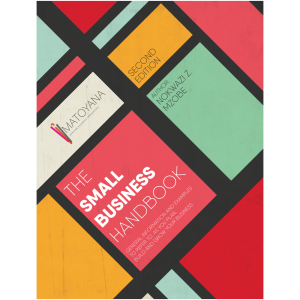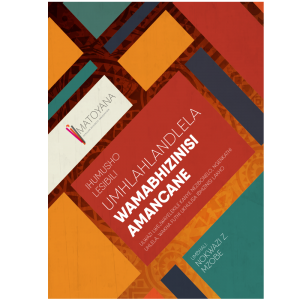We failed!
We failed, but in that failure, we also had some small wins and learnt so much in the process. I am writing this because this is a story worth sharing. It is easy to share our wins, but I guess it is also important (maybe more so) to share our mistakes. I mean, 72% of service and product innovations fail to deliver expectations, according to Strategyzer – that’s significantly high. So, I hope someone else can learn from this (especially solo innovators, small business owners and start-ups), as much as I have.
I knew three months after the launch that the product had failed. Not being the type to give up easily, I explored and tried all the solutions I had at the time to fix the problem. Unsuccessfully. Two and a half years ago, we published and launched ‘Umhlahlandlela Wamabhisinisi Amancane’– the isiZulu version of the Small business handbook. We had identified a problem, and the problem was “there is very little business content written in our indigenous African languages and if we (as a country) are looking to build more SMEs, we should have content accessible in languages where the majority can understand”. We looked to close this gap, by translating the English book – which we had published a year prior, into the most spoken language in RSA – isiZulu. We created a great product. The people we spoke to and engaged with, loved it. But the product failed to take off in the market.
We failed for a number of reasons:
 We failed to properly answer this old age question: “There’s a gap in the market, but is there a market in the gap?” Yes, 23% of the South African population speaks isiZulu, but do 23% read in isiZulu? No. And let’s take this one step further and ask, of those who read isiZulu, how many of them read Business content in their home language? A few, but not enough to make this a viable product that Zulu speaking SMEs would want to purchase and read.
We failed to properly answer this old age question: “There’s a gap in the market, but is there a market in the gap?” Yes, 23% of the South African population speaks isiZulu, but do 23% read in isiZulu? No. And let’s take this one step further and ask, of those who read isiZulu, how many of them read Business content in their home language? A few, but not enough to make this a viable product that Zulu speaking SMEs would want to purchase and read.
We were quick to launch a finished product and we should a have started with a minimal viable product (MVP). If we had done this, we would have had the flexibility to pivot sooner. We did not take time to fully interrogate if a book was the best platform for our target market to learn. As the months went by, and we were getting feedback and more insights, it became clearer that if we had left room to manoeuvre, we could have adapted and delivered the product, in a different format – such as audio or video. We learnt from this book the importance of adapting content to tools that the target market is evolving to as much as the traditional tools.
We failed to properly map out the customer journey
We failed to properly answer this question: “Are customers willing to pay and do they have the ability to pay?” We recognised this early in our research phase so, we went for a third-party business model. Our aim, to make the books accessible to our target audience via our public libraries. We tested this by donating books to a library in Cosmo-City, and we followed up regularly to check interest from library users. It was positive, so off we went and pursued getting into public libraries. We were naïve and did not realise how difficult, almost impossible it would be to get the book into our public libraries if you are an independent or self-published. Yes, we benchmarked the price of the books vs. other similar books in the market, but in the absence of a segment (business books in an indigenous language), we might have missed the mark.
We failed to properly map out the customer journey. We took the same customer journey we had mapped out and designed for the English book and assumed it would work for the isiZulu book. By doing this we overlooked a number of things, for example: E-commerce – we had the book available for purchase online, but our target audience did not purchase online. For the English book yes, 20% of our direct-to-consumer book sales were via the online store – but to date, only 1 isiZulu book (direct to consumer)was ordered online, and it wasn’t via the e-commerce store – it was via email.
 No purchase order, no work
No purchase order, no work
We printed too soon and too many. This time, we will partially own the mistake. Mmmh, no, still our mistake because I should have known better. We received an email – that ‘X’ organization wanted to order books for all their locations in a specific region. At this stage, we had only printed fifty books for marketing and sampling purposes. Considering the turnaround time, it would take to print and deliver – we jumped the gun – we went to print. Not just for the number of copies ordered – which was big, but for a bulk amount which would bring down the cost price per book. I was so focused on trying to maximize margins, I did not think of the bigger implications and cost of this decision.
Well, two months passed, no official order. We got an email that said there has been a system issue hence a delay, but order is coming. Two more months passed, same answer. Another month passed, then another, and another, then silence. While as SME’s we aim to outdo our competition or please our customers with a higher standard of service – we need to always remember the phrase, “no purchase order, no work”. It is a rule to never forget in business.
I guess you must be thinking so many mistakes, so where are the small wins?
We created one of the first (if not the first) business book in an indigenous South African language. Which for me is big, especially in a country where the education and learning systems have historically been used to exclude. Having business learning content only available in English (and maybe Afrikaans) – well this is not serving the majority who need this knowledge.
The biggest win
We know that there is still a need for this content, but not necessarily in the format it was initially delivered. The biggest win (of the small wins) is that we now have the content, completed, proof-read, ready to use for conversion to other formats and it can be used for teaching purposes in schools and colleges.
We did a good job at driving awareness and visibility. We connected with audiences across the nation. The exposure we got on public platforms has helped us create long term relationships with platforms and people, that we otherwise we would not have had.
Let me pause here….and just say that we did sell some Zulu books. We had support from a retailer who was setting up a mobile library as well from individuals who bought the book at expos and conferences. We got listed at an independent bookstore and partnered with a reseller, who sold the book through his platforms. We still have a whole bunch of books sitting. We have donated a few and are hoping to find an opportunity to donate to someone who can ensure that they land in the hands of those who will truly get value from this book.
So, where are we today?
 Well, this article was inspired by something small and exciting that happened this week. We received an email with a one liner: ‘Umhlahlandlela Wama business amancane Ndicela leyo ncwadi + a phone number” translated “The Small Business handbook, may I please have that book”. A gentleman from a rural town, who had heard about the isiZulu book on radio or on TV sent us this one liner email. We then continued our conversation via calls and WhatsApp – explaining the ordering process, sending him payment details – we donated the book and only charged for delivery. At first it was a bit tricky, finding a means to get the book to him since our normal courier company charges high rates for rural deliveries. Sending via the Post office was not an option for us, as we were worried about the long delivery turnaround times. We eventually found an affordable, quick, and reliable means to deliver the book, via Paxi – Pep’s affordable and accessible courier service and he will be able to pick up the parcel at the Pep store in his town. This example shows us the importance of taking time to truly understand your customer base and the importance of designing a value proposition and business model around the real needs of the customer. Well, it is three years later, and we continue to learn from this.
Well, this article was inspired by something small and exciting that happened this week. We received an email with a one liner: ‘Umhlahlandlela Wama business amancane Ndicela leyo ncwadi + a phone number” translated “The Small Business handbook, may I please have that book”. A gentleman from a rural town, who had heard about the isiZulu book on radio or on TV sent us this one liner email. We then continued our conversation via calls and WhatsApp – explaining the ordering process, sending him payment details – we donated the book and only charged for delivery. At first it was a bit tricky, finding a means to get the book to him since our normal courier company charges high rates for rural deliveries. Sending via the Post office was not an option for us, as we were worried about the long delivery turnaround times. We eventually found an affordable, quick, and reliable means to deliver the book, via Paxi – Pep’s affordable and accessible courier service and he will be able to pick up the parcel at the Pep store in his town. This example shows us the importance of taking time to truly understand your customer base and the importance of designing a value proposition and business model around the real needs of the customer. Well, it is three years later, and we continue to learn from this.
Nokwazi Z Mzobe, Founder of Matoyana Media






